
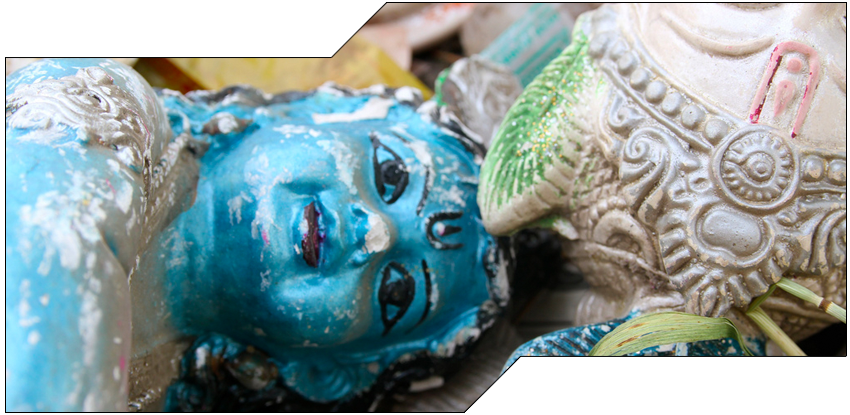
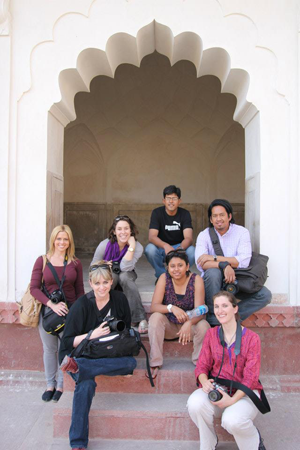
Americans who assumed society was becoming increasingly secular were wrong. Not only did religion roar back in American politics, but it also assumed a central role in events ranging from the Saffron Revolution to the Arab Spring. And even if some pundits still insist that religion is just a stalking horse for political and economic forces, many other observers are rethinking the tenacious hold of faith-based beliefs and behaviors. Yet much of the US mainstream media, unprepared for religion’s global resurgence, tends to ignore, underplay or trivialize its significance. USC Annenberg’s J585 Reporting on Global Religion offers an alternative—preparing the next generation of reporters to incisively and intelligently cover news at the intersection of ethics, religion or spirituality.
In Spring 2012, J585 students focused on reporting about the effect of caste and religion on South Asian culture and society in India and in Southern California. The foundation for caste, a much-misunderstood social system, is in ancient Hindu texts, but the classifications continue to delineate social and economic spheres for India’s Sikhs, Buddhists, Jains, Muslims and Christians at home and abroad. J-585’s assignment was to investigate how caste and religion affect Indian law, business, gender relations and politics. At the very moment when India is poised to be a world power, how, where and why does caste affect its citizens? How does it affect Indian immigrants?
Starting in January, the class dove into the literature of an unfamiliar religion, region and civilization. Students read deeply, sought out academic experts, tracked online news from India and reported on Southern California’s South Asian community. They visited Sikh gurdwaras and Hindu temples, met matchmakers and gurus, and probed sexual mores, labor relations and community politics. By mid-February, increasingly knowledgeable about India, they reached out to potential sources and fleshed out reporting plans for an 8-day trip to Delhi. When March began, students had several projects underway, including plans to learn more about India’s growing surrogacy industry, its Tibetan population, and legal challenges to the reservation system, the Indian “affirmative action” program that sets asides educational and vocational spots for India’s poorest citizens.
On March 7th, J-585 departed for Delhi.
J585 Trip Roundup:
After five hours of Downton Abbey, three hours of Fringe, some Glee catch-up and a layover in Dubai, arriving in India felt anti-climactic. As we waited outside the Delhi airport for a van, the night was quiet, the air unscented and the inky black sky almost starless. Our driver seemed as new to Delhi as we were. Bobbing and weaving through late-night traffic, he circled around the same boulevards until he pulled up to on the wrong hotel. He was aggrieved when we refused to disembark and resumed his seat only after a string of high-pitched phone calls to his company and our fixer. Soon delivered to the right lodging, we had no more luck with the desk clerk, who refused to hand out internet passwords. Were we back in Israel? My spartan room resembled the Christian guest quarters in Jerusalem’s Old City where I had stayed with last year’s class, but no early-morning prayer calls shattered our sleep this time around.
By daylight, the India International Centre (IIC) appeared more hospitable with its wide, green lawns and rows of pink and purple flowers. But our plans to huddle at breakfast were dashed when we learned that no more than five people could convene at any table – whether in the restaurant, coffee shop or bar. Seeking to prevent rowdy groups from disturbing elderly, academic guests, the Centre permitted large gatherings only on the back lawn. Thus began a tradition of J585 damp-grass, morning meetings. That first day, we drew Sohail Hashmi, a Muslim journalist, into our circle of plastic chairs. Hashmi, bearded and dignified , launched into a passionate denunciation of the U.S., starting with the Vietnam War. We listened politely for 20 minutes then asked about religion and politics in India. I was surprised to learn that even good Hindus knew where to buy a steak in Delhi.
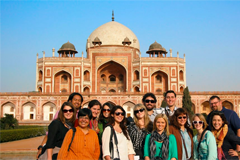
Late morning, our fixers brought us to Chandni Chowk, a veritable tunnel of bodies, ramshackle buildings and roiling traffic that is Old Delhi’s main thoroughfare. A centuries-old market hub, the street is lined with pavement-hugging peddlers, pushcarts topped with oranges, coconuts and flies, and hipsters trolling for bargains. Free of traffic signals, cars, vans and buses vied with human-powered rickshaws and mini-mobiles to push pedestrians to the curb. In rapid succession, we visited a Jain temple, a Hindu shrine and Sikh gurdwara, quickly realizing how little our background research had really told us about the rituals and teachings of these traditions. We walked barefoot on the pavement before entering the gurdwara and accepted wet, greasy dough balls on the way out. After lunch we headed to the Jama Masjid, one of the largest mosques in Delhi, and then to Humayan’s Tomb, a Mughul-era monument that inspired the Taj Mahal. By sunset we were lolling at India Gate—some of us eager to return to the IIC. Early on Day 2 we boarded a mini-bus that took us to a slum on the northern outskirts of Delhi. Shahabad Dairy, once a pastoral vista, is now a cramped, wire-strung warren of shacks, hovels and ruins that houses more than 100,000 men, women and children. Our guides belonged to Cooperative Outreach of India, a Christian NGO that provides education and support groups for residents while seeking to evangelize them. One of their young members, a co-ed from Georgia who came to India to do God’s work, explained missionary service to the students. Once off the bus, the J585ers started clicking, as if snapping photos might somehow save the slum’s children. Marveling at the poverty, the students captured images of youngsters picking through dung piles, water buffalos ambling down unpaved streets, illegal cables snaking through pink and yellow homes and, always, another big-eyed child begging for a rupee. The students were no less awestruck when, several hours later, we lunched at a five-star hotel. The elegant buffet featured delicacies from China, France and the U.S. as well as Indian specialties. We dined on haricots verts and chocolate tarts, roast beef and ice cream. Bellies full, we returned to the bus and headed to the home of Mark Tully, a retired BBC journalist who had settled in Delhi.
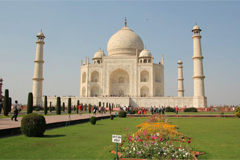
At seven the next morning we met in the hotel lobby to board another van, this time to Agra. This day trip to the Taj Mahal was our one concession to tourism. It was Sunday, and traffic crawled. After creeping through the toll booths, we sped past gasoline rigs and trucks piled high with chicken coops. The land on either side of the highway was overgrown with tightly packed, grey-green strip homes, then dusty fields. We careened and swerved between cars, but the trip still took longer than anticipated. Worse, when we finally arrived, we were dropped at the Agra Fort, not the Taj. The fort was actually a palace complex built by 17 th-century Mughal emperors for friends, family and concubines. There was a large stone outdoors bath (for concubines), several carved recessed balconies (for concubines), large sitting rooms and bedrooms (for concubines) and a white marble wing with walls inlaid with semiprecious stone for family-- it’s where one emperor “detained” another, his father. Most of the fort was in terrible shape— mosaics and artwork long gone and rooms battered by conquerors and climate—but the “bones” revealed an artistic and architectural masterpiece of commingled Hindu-Islamic motifs. The fort was so unexpectedly majestic that I feared the Taj Mahal would be a disappointment. That concern grew stronger on the road leading to the Taj. It was dotted with Disneyfied souvenir shops, and then long entry lines twisted and turned like the queue at Space Mountain. There was a metal scanner and a pat down, then a four-sided courtyard and a narrow entry-gate. Mounting the steps in front of me, locals and tourists jostled then abruptly pulled up short. I pushed through and saw why. The Taj shimmered in the afternoon light. My heart tugged: I need to see it at dawn and dusk. My thought surprised me, and I realized that I was looking at something that couldn’t be tamed by irony or mastered through cynicism. Awed, I looked away, unsettled by the strength of my feelings. LINK
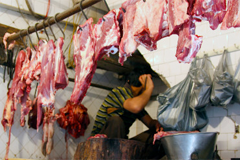
Once the week began, students scattered. They were collaborating on several large projects, including stories about the growth of the Muslim-dominated beef industry and a legal challenge to the reservations system that sets aside spots for low-caste Hindus, Jains, Buddhists and Sikhs but not Muslims or Christians. Given the difficulties of navigating Delhi, progress was slower than most anticipated. Students hired out cabs for the day and some braved the subway system, but it wasn’t unusual to spend an hour and a half traveling from one appointment to the next.
On Tuesday we began scheduling one or two group activities per day. Mid-afternoon that day we gathered at Zubaan Books, where we met Urvashi Bhutalia, a journalist and activist who co-founded India’s first feminist press and who now runs Zubaan. The shop was tucked on a winding street in an upscale neighborhood with fashionable boutiques and an Italian pizzeria. As we ate pizza and calzone, Bhutalia and her staff talked with us about gender, religion and caste in India. From there we went to Hanuman Temple in Connaught Place. Hanuman is the Hindu deity with the head of a monkey. Tuesdays and Saturdays are auspicious days to pray to him. In the large plaza outside the temple, vendors sold flowers and sweets for the god. Others offered bangles and street food for the worshippers eager to get inside the temple.
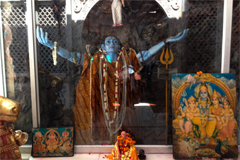
A long line had already formed when we were asked to remove our shoes and ushered inside. We waited in a tightly packed green anteroom before being shepherded into the sanctuary. Crammed with scores of devotees, we stood facing the altar where priests waved incense braziers before a silver idol. The clang of gongs surrounded us and we were overwhelmed by the soundscape. Beneath the full tones of the bell ringing, voices chanted in Sanskrit with the eerie otherworldliness of Pentecostals speaking in tongues. It’s a form of worship aimed to subdue the rational mind and push the participant into an altered state. Still, after we left, I wanted to look at sari shops. That evening, students continued to follow stories. Some visited gay bars, others sought after-hours artists, still others—in runs for cigarettes or take-out—encountered Delhi street life.
They took off after the Wednesday morning meeting with promises to reconnect midday at the Center for Developing Societies. The Center, an academic think-tank, is the academic home for Madhu Kishwar, a scholar and activist who started Manushi, a journal about issues facing women and society in India. In recent years, as her work has become more focused on the very poor and on Muslims, Kishwar’s positions have become controversial. But in her discussions with us, she was sober and thoughtful. We left her and headed to the Baha'i House, where we sat in on a press conference promoting an interfaith initiative to distribute mosquito nets to the poor. The evening was warm, the setting Old India lush and the cause was noble. We had three days more.
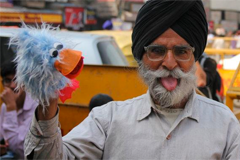
Our remaining time was spent backfilling stories and shopping. Students remembered all the places they had meant to visit and packed some in—the Lotus Temple, the Lodhi Gardens and Nizamuddin, the Sufi shrine among others. On Thursday evening, we gathered at the Chatterpur Temple with Gaurav Srivastara, a USC student who had promised to guide us through the large complex. Gaurav is from Delhi, and his family heads a company that produces Hindu media. He led us through the shrines on the 60-acre campus, and we ended up at the main temple, where we participated in the evening service. The liturgy was broadcast to more than 60 countries, and we saw our faces on the monitor as we sat, cross-legged on the floor, watching the priests’ ministrations to the gods. Afterwards, Gaurav introduced us to the temple’s CEO who discussed the complexities of religious life in India.
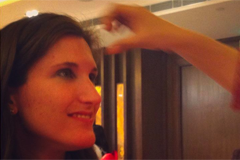
Friday was free except for a late afternoon meeting with Chandan Mitra. Mitra is the editor The Pioneer Newspaper and a member of the Indian Parliament. He said he had 20 minutes for us but when we begin to talk, he lost track of time. Mitra is a member of the Bharatiya Janata Party (BJP), which started in 1980 as a conservative, Hindu nationalist, free market capitalist alternative to the dominant Nationalist Party. Charming and intelligent, Mitra spoke confidentially to us, explaining BJP strategy and offering insights on Indian politics. We left his newspaper office feeling privy to Delhi’s inner workings. Back at the hotel we had a short time to get ready for a small party that Gaurav had arranged for us. Returning to the five-start hotel, we were ushered into a small banquet room decorated in USC cardinal and gold. Indian musicians sat on a small stage playing traditional music. Young women painted red marks on our foreheads and waiters offered wine, Scotch and soft drinks. A panel of eminent Indian journalists spoke to us about the domestic press (Headline: It’s booming) and answered our questions on differences in coverage and the state of the industry in India and in the US. We ate, we drank, and we toasted one another. It was the perfect conclusion to an exhilirating week.
-- Diane Winston
Published Work





